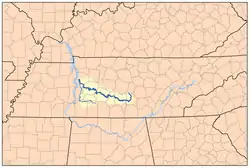Duck River (Tennessee)
The Duck River, 284 miles (457 km) long,[1] is the longest river located entirely within the U.S. state of Tennessee. Free flowing for most of its length, the Duck River is home to over 50 species of freshwater mussels and 151 species of fish, making it the most biologically diverse river in North America.
| Duck River | |
|---|---|
 | |
| Physical characteristics | |
| Length | 284 miles (457 km) |
The Duck River drains a significant portion of Middle Tennessee. It rises in hills near an area of Middle Tennessee known as the "Barrens", an area with enough rainfall to support a woodland but which white settlers found already deforested upon their arrival. (Several theories have been advanced to explain this phenomenon.) It enters the city of Manchester and meets its confluence with a major tributary, the Little Duck River, at Old Stone Fort State Park, named after an ancient Native American structure between the two rivers believed to be nearly 2,000 years old.
Other major towns along the Duck include Shelbyville, Columbia, and Centerville. Below Shelbyville to the Southeast, the Duck is impounded by Normandy Dam, a Tennessee Valley Authority project of the early 1970s which was built for flood control and recreation. Normandy was not equipped for power generation as were previous TVA dams built in Middle Tennessee. The structure was named for the hamlet of Normandy, which is nearby. The resultant reservoir occupies over 5,000 acres (2,000 ha) of what was previously prime land for agriculture. Further downstream, Shelbyville is protected from potential Duck River flooding by levees and floodgates. A dam constructed by the Tennessee Electric Power Company across the river adjacent to downtown Shelbyville is a relic of the early electrical development of the area prior to the establishment of the Tennessee Valley Authority.

Downstream in Maury County is the Yanahli Wildlife Preserve, occupying land which was meant to be another TVA reservoir. The Columbia Dam was never completed, however, when an endangered species of mussel was found in this section of the Duck and studies showed the project costs would far exceed benefits. After years of litigation, the dam, which was largely completed, was dismantled at a loss approaching $80,000,000 of public funds. Another old Tennessee Electric Power Company dam, somewhat similar to the one in downtown Shelbyville, is located downstream of the uncompleted dam site. Private funds have been spent on this dam to rehabilitate it to resume electrical power production; however, this has not proven to be successful. The Duck River frequently floods parts of Columbia, particularly the neighborhoods near downtown.
Between Columbia and Centerville, the Duck cuts through the Western Highland Rim and is joined by several major tributaries, notably the Piney River. Downtown Centerville is located high above the Duck River bottoms. Below Centerville, the Duck again enters a fairly rural, somewhat remote area. Its largest single tributary, the Buffalo River, reaches its confluence with the Duck in southern Humphreys County, just a few miles from the mouth of the Duck into the Tennessee River. The area of the mouth of the Duck is part of the Tennessee National Wildlife Refuge.
See also
References
- U.S. Geological Survey. National Hydrography Dataset high-resolution flowline data. The National Map Archived 2012-03-29 at the Wayback Machine, accessed June 8, 2011